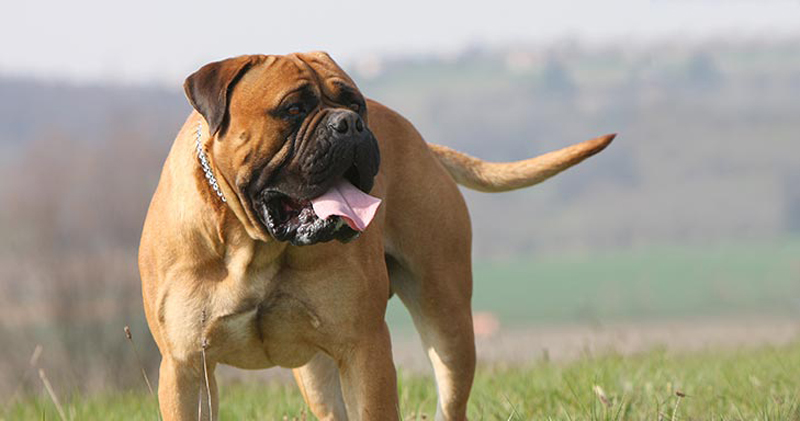Bullmastiffs are a formidable breed, known for their impressive size and protective nature. Originating in the United Kingdom during the late 19th century, they were bred by gamekeepers to guard estates and deter poachers, a role that required both bravery and restraint. Today, Bullmastiffs are valued not just for their ability to guard but also for their calm demeanor and loyalty as family pets. Despite their somewhat intimidating appearance, Bullmastiffs are known for their affectionate and gentle traits towards their owners. Along with these characteristics, Bullmastiffs exhibit several unusual habits that are deeply ingrained in their genetic makeup and historical roles. These behaviors not only highlight their unique qualities but also present specific challenges that require understanding and management by their owners. This article will explore seven of the most unusual habits of Bullmastiffs, providing insights into their origins and offering tips on how to handle these distinctive traits effectively.

1. “Silent Guarding”
Unlike many breeds known for their barking, Bullmastiffs often use a more subtle approach to guarding, known as “silent guarding.” This behavior involves standing still and silent, assessing the situation quietly rather than barking or growling loudly. This habit stems from their days as estate guardians, where stealth was necessary to catch poachers unawares. Owners should be aware of this trait, as it means a Bullmastiff might not always alert them audibly to potential threats. Training to encourage some vocalization when necessary can help ensure they can effectively alert their owners without compromising their natural guarding instincts.
2. Leaning on Their People
Bullmastiffs often exhibit a behavior affectionately known as “leaning,” where they physically lean their bodies against their owner or family members. This is thought to be a sign of affection and a way to feel connected to their people. While endearing, this habit can be overwhelming due to their large size, especially for children or the elderly. Teaching them from a young age to be mindful of their body positioning can help manage this behavior while still allowing them to express their affection.
3. Resistance to Obedience Training
Due to their independent nature, Bullmastiffs can sometimes show a marked resistance to obedience training. They were bred to make autonomous decisions in the field, which can translate into a stubborn streak during training sessions. Patience, consistency, and positive reinforcement are key in training Bullmastiffs. It’s important to establish clear leadership and use training techniques that engage them mentally and respect their intelligence.
4. Low Energy but Sudden Bursts of Play
Bullmastiffs are generally low-energy dogs that enjoy lounging around the home. However, they can exhibit sudden bursts of playfulness, often surprising their owners with their agility and speed during these short episodes. Encouraging regular, moderate exercise can help manage their energy levels and maintain their health, as keeping a Bullmastiff active is crucial to preventing obesity and other health issues.
5. Snoring
Due to their brachycephalic (flat-faced) nature, Bullmastiffs are prone to snoring, often loudly. This can be a charming quirk but also a sign of potential breathing issues. Owners should monitor their Bullmastiff’s breathing and consult a vet if the snoring seems to be linked to breathing difficulties or if it significantly worsens, as it might require medical attention to ensure there are no obstructive issues.
6. Extreme Loyalty and Protection
Bullmastiffs develop deep bonds with their families, often becoming extremely loyal and protective. This loyalty can manifest in overprotective behavior, especially around strangers or new guests. Socialization is critical in helping them understand how to behave around new people and in unfamiliar situations. Regular, controlled exposure to various social situations from a young age can help ensure they react appropriately.
7. Destructive Chewing
Like many large breeds, Bullmastiffs may engage in destructive chewing, especially as puppies. This can be driven by boredom, teething, or anxiety. Providing sturdy chew toys, engaging them in regular physical and mental activities, and crate training can help mitigate unwanted chewing. Ensuring they have appropriate outlets for their chewing instincts is important for safeguarding your home and keeping them satisfied.
Bullmastiffs are a breed that combines strength with a gentle spirit, characterized by several unique habits that require understanding and appropriate management. Recognizing and accommodating these behaviors can greatly enhance the bond between Bullmastiffs and their owners, ensuring these loyal guardians are happy, healthy, and well-integrated family members. With the right approach, the unusual habits of Bullmastiffs can be managed effectively, allowing their best qualities to shine through.
 Toledo, United States.
Toledo, United States.